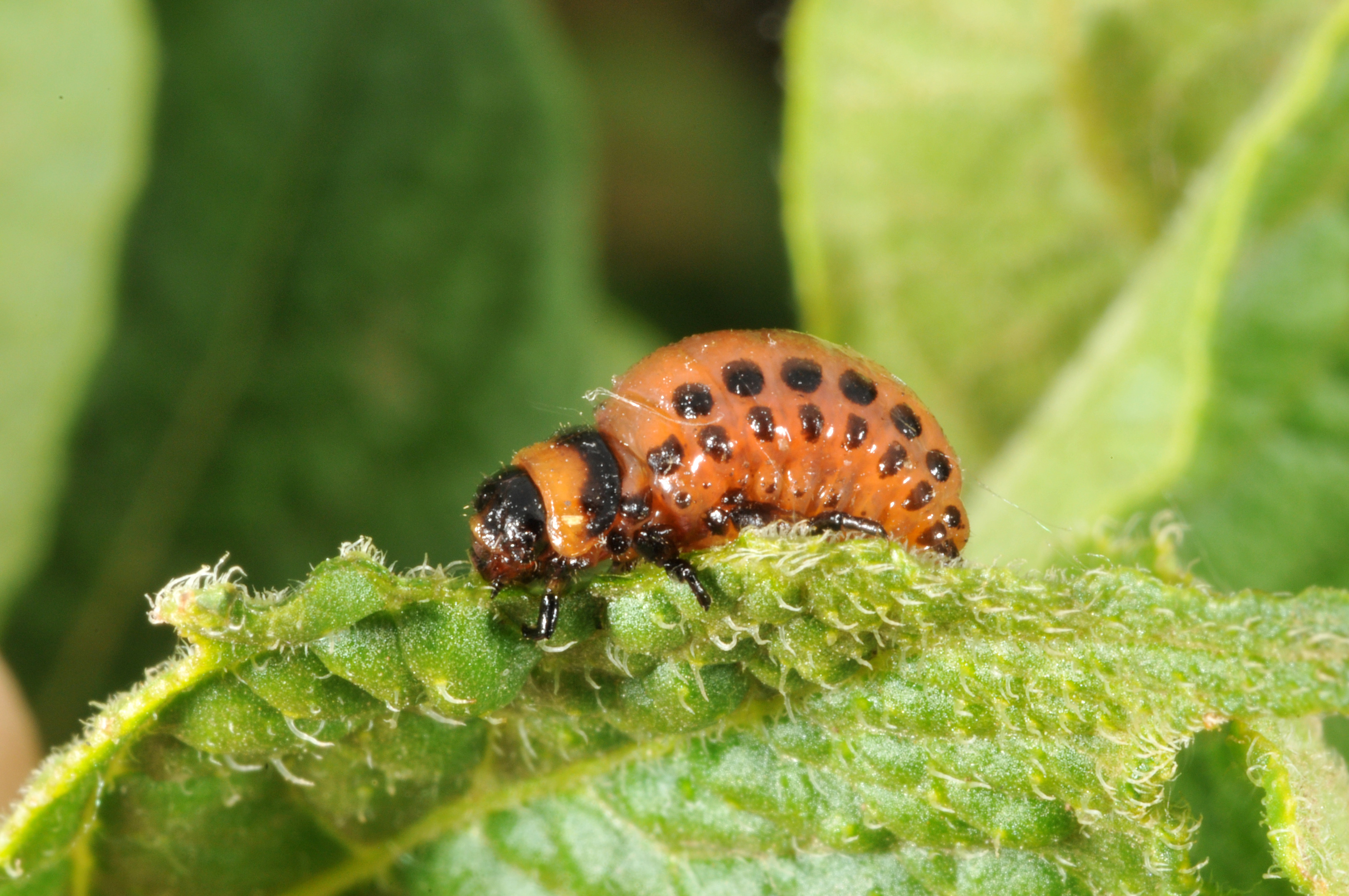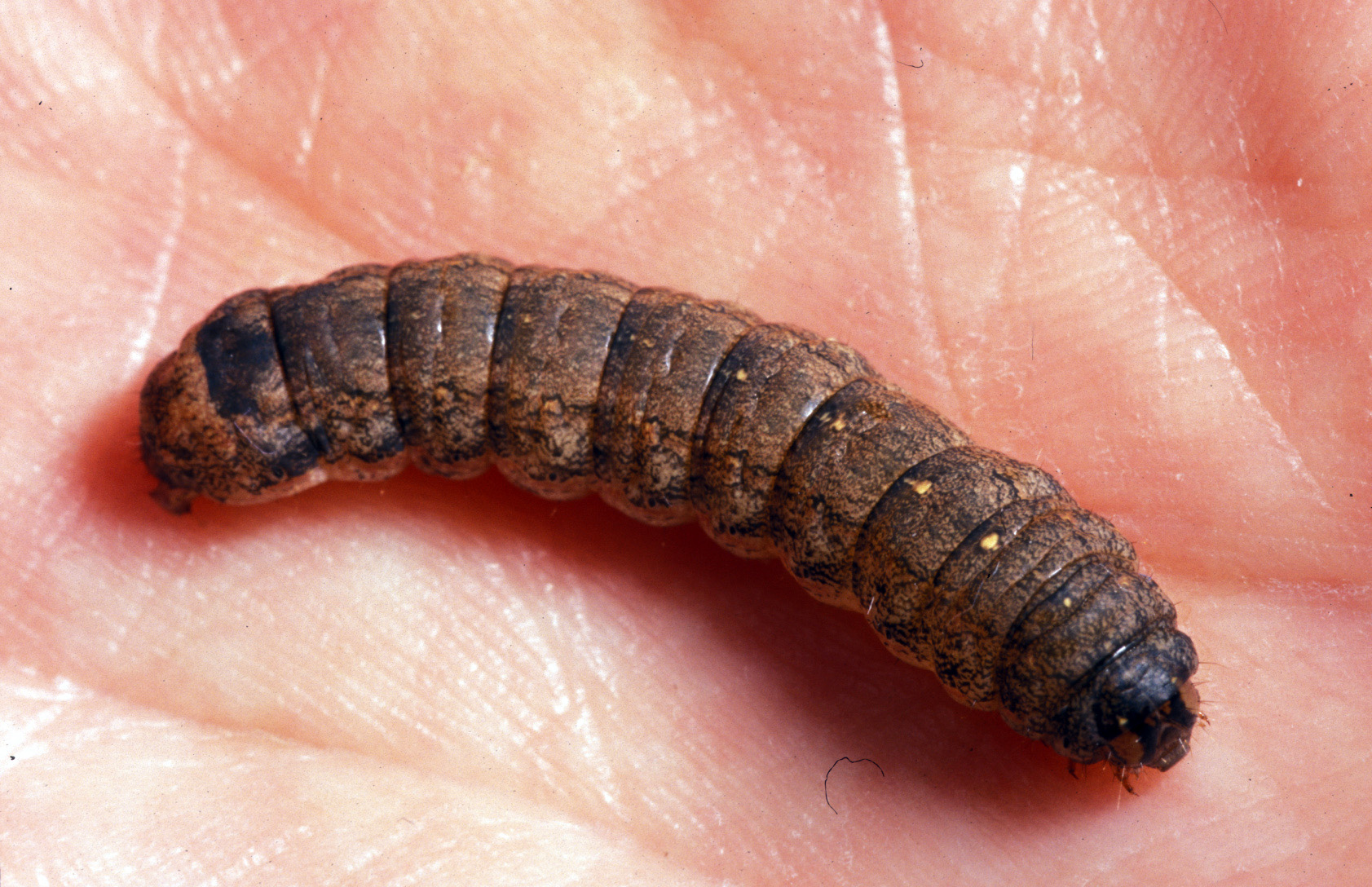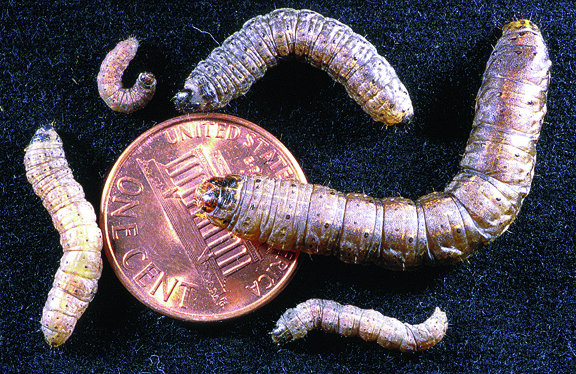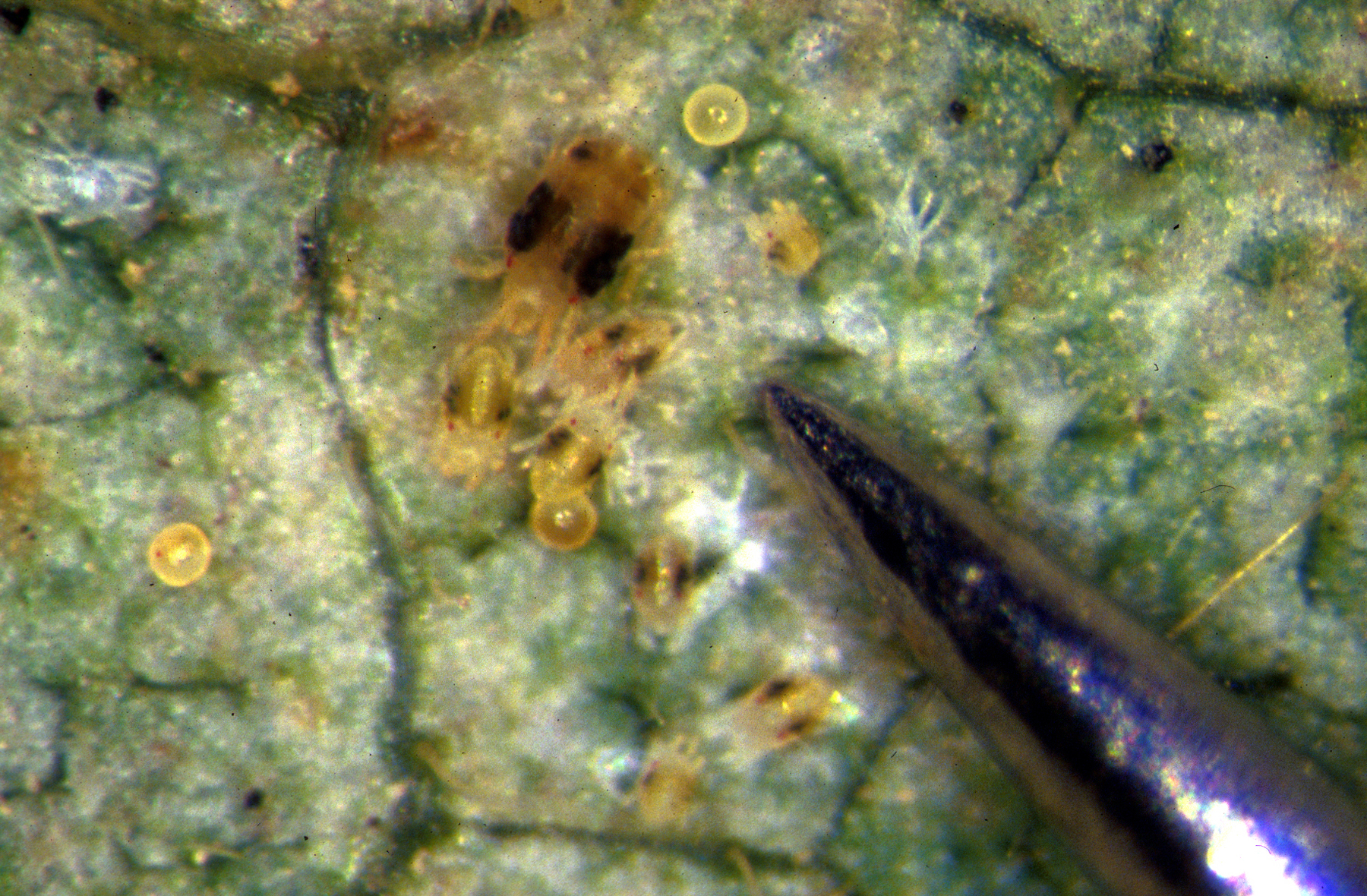Vegetable Insects
MANAGEMENT OF INSECT PESTS ON FRESH MARKET TOMATOES
Ricky E. Foster, Extension Entomologist
If you want to view as pdf, click here
Fresh market tomatoes can withstand considerable feeding on the leaves, but very little insect damage directly to the fruit. Fortunately, there are few insect pests in Indiana that seriously damage tomato fruit.
TOMATO FRUITWORM
The tomato fruitworm, also known as corn earworm and cotton bollworm, is a yellowish-brown moth with a wingspan of 1 1/2 inches. The caterpillars vary in color, but are usually light green with splotches of color (tan, brown, pink, maroon, etc.) running lengthwise on their bodies.
Tomato fruitworm larva
(Photo Credit: G. Brust)
Female moths prefer to lay their eggs on corn, especially sweet corn. They also lay eggs on tomato plants (usually near flowers), on terminal leaflets, or underneath the calyx of green fruit.
Corn earworm adult
(Photo Credit: J. Obermeyer
When eggs hatch, caterpillars quickly begin to bore deeply into the fruit, contaminating the area with feces. Caterpillars prefer to feed on green fruit and will seldom enter ripe fruit.
Because caterpillars damage the fruit directly with only minor feeding on leaves, protectant insecticide sprays are necessary when moth populations are high. If an insecticide is already present on the fruit, any caterpillars that hatch will come into contact with a lethal dose of the insecticide. Eggs are not affected by most insecticides. However, these prophylactic sprays are only necessary when tomato fruit are present and tomato fruitworm moths are being caught in pheromone traps. If moth catches are low (1-4 moths per week), sprays are not necessary. The presence of silking corn in the area will usually divert moths from tomato to corn. When trap catches reach 7-8 male moths per week, an insecticide should be applied.
Also, excessive sprays of many insecticides can lead to outbreaks of secondary pests (mites and aphids) that are normally controlled by natural enemies.
HORNWORM
Hornworms can make a big impression on growers because of their size and damage to tomato plants. However, they are rarely numerous enough to cause any significant damage. Hornworms can be 3-4 inches in length, are usually blue-green, have a “tail” or horn on their second to last body segment, and have 7-8 white stripes running diagonally along the sides of their bodies. Moths are active in late June to early July. Caterpillars sometimes eat green fruit, but usually consume large amounts of foliage in a rather short time.
When hornworms are large, 2-4 inches, insecticides may not control them. They are best controlled when still small, 1/2 - 1 3/4 inches. So, scout fields for hornworms starting in late June. Watch for hornworms, plants with feeding damage, or the presence of frass (feces). However, when feeding is found, hornworms are small (less than 2 inches), and 2-4% of plants throughout a field show severe feeding, then a treatment is necessary.
Hornworm larva
(Photo Credit: J. Obermeyer)
YELLOW STRIPED ARMYWORM
Yellow striped armyworm (YSA) has always been a pest in Indiana, but in the last few years, has become more of a problem especially in high tunnels. The caterpillar normally overwinters in warmer areas of the U.S. and moves up into the Midwest later in the summer (August).
The caterpillars can be pale gray to black. There is usually a yellow or cream colored strip running along the length of its body. On the first abdominal segment, there is a large dark spot (see arrow) on either side of its body. Eggs are laid in groups of 20-30 near fruit. Small larvae feed on leaves for a short time and then attack fruit. Feeding damage to fruit consists of 1/8 – 1/4 inch wide holes, over the entire fruit and fruit cluster. One or two larvae can destroy two to three clusters of tomato fruit.
Yellow striped armyworm larva
(Photo Credit: J. Obermeyer)
Leaves must be insepected in June so that YSA can be found when small and before it feeds on fruit. Identification of the pest is essential to understanding when controls should be started. Growers MUST watch for this pest in their tomatoes each year, because its population will fluctuate greatly from year to year and field to field. The presence of the yellow striped armyworm one year does not necessarily mean it will return next year to that or neighboring fields.
COLORADO POTATO BEETLE
The Colorado potato beetle (CPB) is a pest of any solanaceous crop (e.g., tomato, potato, eggplant, and peppers). CPB prefer potato and will not feed as extensively on tomato. The adults are yellow with 10 black stripes on their wing covers. Eggs are oviposited on the underside of the leaf and are yellowish-orange color. Larvae are orangish-pink with black heads and two rows of black spots along the sides of their bodies.
Both adults and larvae feed on leaves. Growers can avoid damage from this pest by locating their field at least 1/2 mile from any solanaceous crop. Fields should be scouted for any adult beetle activity throughout the season. CPB can be best controlled by controlling 1st or 2nd instar larvae. Treatment may be necessary if there is more than one adult, larvae, or egg mass per plant when 50 plants are checked throughout the field.
Colorato potato beetle, (top) larva; (bottom) adult
(Photo Credit: J. Obermeyer)
CUTWORMS (VARIEGATED, AND BLACK)
The variegated and black cutworm are sporadic pests of tomato. Variegated cutworm moths are large, 1 1/2 inches in long, greyish-black, and lay eggs on stems or lower leaves at night in spring or summer. Larvae can reach 1 1/2 inches in long, and are brownish-black with 5 or 6 orange spots along their back.
Female black cutworm moths are active early in the season and prefer to oviposit on low-lying winter annual weeds. Larvae reach 1 1/2 - 2 inches in length and are greasy black in appearance.
Variegated cutworm, (top) (bottom) adult
(Photo Credit: John Obermeyer
Black cutworms
(Photo Credit: J. Obermeyer)
Both cutworm larvae feed at night and can cut small plants at or 1-2 inches above the soil surface. Once plants are 1-foot tall, treatment should be unnecessary. Fields should be scouted in the early morning (up to 2 hours after dawn) for the presence of larvae or their damage. One larva per 100 plants and the presence of cut plants indicate that control is necessary. Fields that have many winter annual weeds, such as chickweed or henbit, should be worked (or weeds destroyed) at least 10-14 days before any tomato plants go into the field. Cutworm moths lay eggs on these weeds and cutworms will begin feeding there. If fields are not worked early enough, cutworms will survive and feed on tomatoes. Variegated cutworms can also feed on the foliage or small fruit of mature plants, because of this they are also called “climbing cutworms.”
Adult variegated cutworms can be monitored with pheromone traps. Seven or more adults per trap per week indicate treatment is necessary in 7-10 days. However, these pests will rarely produce economic damage.
FLEA BEETLE
Flea beetles are very small (1/16 - 1/5 inch long), usually dark-colored beetles that, when disturbed, can quickly hop away. Flea beetles feed on the leaves and create small, round holes. Flea beetles are not a problem unless their populations become very high and/or feeding damage is severe. Fortunately, several insecticides can control these pests fairly easily.
Palestriped flea beetle and damage
(Photo Credit: J. Obermeyer)
APHIDS
Aphids are soft bodied, light to dark green insects about the size of a pinhead. Aphids (adults and immatures) suck sap from the plant. They are usually found on the underside of leaves. Because of their small size, hidden behavior, and rapid reproduction, aphid populations can become very large before they are noticed.
Aphids damage fruit in two ways. First, by sucking sap from leaves, they reduce the vigor and growth of the plant, which can reduce yield. Second, aphids produce “honeydew,” a sticky liquid on which a black fungus grows. This honeydew can get on tomato fruit, making them unmarketable.
Aphids can be pests throughout the growing season. Fields should be scouted weekly and the underside of leaves checked for aphids. Fortunately, aphids are controlled by a number of natural enemies. Therefore, insecticide sprays should be kept to a minimum to prevent the destruction of the aphids’ natural enemies.
Aphids and cast skins on tomato leaf
(Photo Credit: J. Obermeyer)
SPIDER MITES
Adult twospotted spider mites (TSM) are extremely small, 1/80 - 1/60 inch long, with 2 spots on their back. Female mites lay 50-100 eggs. Unfertilized eggs turn into males, and fertilized ones turn into females. The life cycle of the mites can be as short as 5-7 days in the summer.
Adult TSMs overwinter in weedy areas around the field. Mite infestations usually start on the field edge. In spring, TSMs feed on weed hosts, such as chickweed, clovers, and some grasses. The optimal condition for rapid increases in mite population is hot (>80°F), dry (<50% RH) weather. This weather favors rapid development of eggs to adults, increases feeding, and decreases the abundance of pathogenic fungi. Dusty conditions also favor mite activity
Twospotted spider mites
(Photo Credit: J. Obermeyer)
TSM damage appears as a yellow discoloration or a mottled sand blasted appearance on tomato leaves, which can take on a bronze, then brown color. Mites feed by piercing the cell walls of the leaf and sucking out the juices.
If hot, dry conditions continue for several weeks, then fields should be checked closely, especially along borders and near grassy areas. The underside of several lower leaves should be checked for mite activity. A 10X hand lens can be used to identify mites. Also, leaves can be shaken over a piece of paper, and the dislodged mites can be seen crawling about. If mites are found along the border of a field, the whole field should be checked for the presence of mites.
An exact threshold for mites has not been developed. If there are only a few mites along the field borders with little mite activity on the interior of the field, then a treatment is probably not necessary, or just the border around the field may be treated. If there are mites found in scattered areas throughout the field and there is webbing found on the undersides of leaves, then a treatment will be necessary. Natural enemies help control and reduce mite populations under most circumstances except under hot and dry or dusty conditions. Therefore, insecticide applications should be kept to a minimum. Natural enemies, however, can be overwhelmed by mite reproduction during hot, dry weather.
POTATO LEAFHOPPERS
Potato leafhopper commonly feeds on tomatoes, but is rarely an economic problem. The adult is 1/8 inch long and yellowish-green. Adults are blown in on southerly winds in the spring. Nymphs are small versions of the adult that cannot fly.
Potato leafhoppers feed on the underside of the leaf by sucking juices from the plant. They cause a characteristic yellowing or browning of affected tissue known as “hopperburn.” However, this damage is rarely seen on tomatoes.
Leafhoppers are easily controlled with insecticide applications. They only need be treated when large populations are observed when fields are scouted, or at the first sign of hopperburn.
Potato leafhoppers adult (l) and nymphs (r)
(Photo Credit: J. Obermeyer)
HIGH TUNNELS
Tomatoes are the most common vegetable grown in high tunnels. The Office of the Indiana Chemist defines high tunnels as being the same as a greenhouse. Pesticide labels may specify that they can be used in greenhouses (and high tunnels), others specify that they cannot be used in greenhouses, or don't specify. If the label is silent about greenhouses, the State Chemist has ruled that those insecticides can be used in greenouses. Because pesticides are unlikely to degrade as rapidly in high tunnels as outdoors and workers have more contact with the plants, growers are encouraged to select the least toxic option when selecting pesticides.
Plants in the high tunnels
(Photo Credit: J. Obermeyer
For specific insecticide recommendations, refer to ID-56, Midwest Vegetable Production Guide for Commercial Growers http://www.btny.purdue.edu/Pubs/ID/ID-56/.
Tomato fruitworm - Helicoverpa zea (Boddie)
Tomato hornworm - Manduca quinquemaculata (Haworth)
Tobacco hornworm - Manduca sexta (L.)
Yellow-striped armyworm - Spodoptera ornithogalli (Guence)
Colorado potato beetle - Leptinotarsa decemlineata (Say)
Variegated cutworm - Peridroma saucia (Hubner)
Black cutworm - Agrotis ipsilon (Hufnagel)
Flea beetles - Several species
Twospotted spider mites - Tetranychus urticae Koch
Potato leafhopper - Empoasca fabae (Harris)
READ AND FOLLOW ALL LABEL INSTRUCTIONS. THIS INCLUDES DIRECTIONS FOR USE, PRECAUTIONARY STATEMENTS (HAZARDS TO HUMANS, DOMESTIC ANIMALS, AND ENDANGERED SPECIES), ENVIRONMENTAL HAZARDS, RATES OF APPLICATION, NUMBER OF APPLICATIONS, REENTRY INTERVALS, HARVEST RESTRICTIONS, STORAGE AND DISPOSAL, AND ANY SPECIFIC WARNINGS AND/OR PRECAUTIONS FOR SAFE HANDLING OF THE PESTICIDE.
March 2016

It is the policy of the Purdue University Cooperative Extension Service that all persons have equal opportunity and access to its educational programs, services, activities, and facilities without regard to race, religion, color, sex, age, national origin or ancestry, marital status, parental status, sexual orientation, disability or status as a veteran. Purdue University is an Affirmative Action institution. This material may be available in alternative formats.
This work is supported in part by Extension Implementation Grant 2017-70006-27140/ IND011460G4-1013877 from the USDA National Institute of Food and Agriculture.
1-888-EXT-INFO
www.extension.purdue.edu
Order or download materials from www.the-education-store.com
















